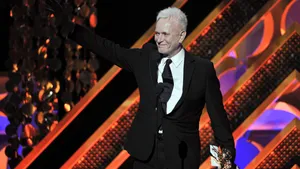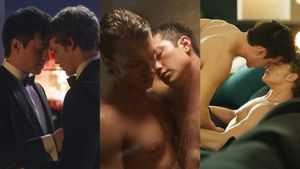During LGBT History Month, I've been thinking about the lesbian themes in Walk on the Wild Side (1962), one of my favorite classic films, and the movie's place in Hollywood history. Based on a Nelson Algren novel and directed by Edward Dmytryk, it stars Laurence Harvey, Barbara Stanwyck, Capucine, Anne Baxter, and Jane Fonda -- the only principal cast member who is still with us -- in a Depression-era story set in a brothel. As far as classic LGBT films go, it wasn't as groundbreaking as The Children's Hour (1961), with Shirley MacLaine and Audrey Hepburn, but it's still engaging and has some memorable performances, and it helped move the needle on representation. The 1960s were pivotal in many respects, and with the advent of free love and the weakening of the Production Code (the predecessor to the MPAA rating system), gay characters could open the closet door a bit wider than before.
In the classic films I have seen, ranging between the 1920s and the 1960s, gays aren't portrayed in a flattering light -- rather, they are objects of ridicule, pity, hatred, or all three. The "archetypes of gays being part of the illicit subculture of society," as one blogger put it, go unchallenged in this film. The script went through many writers and rewrites; according to the Turner Classic Movies website, some scenes in certain drafts "were basically soft core porn, routinely discarded by the director, with the cast's full approval." Did those cut scenes imply sex? Maybe a lesbian kiss, like what Marlene Dietrich delivered in Morocco (1930) or Greta Garbo in Queen Christina (1933)? To me, it's clear enough that madam Jo (Stanwyck) and prostitute Hallie (Capucine) are involved, but it would have been great to see sapphic intimacy that couldn't be straightwashed as friendship or something else.
When Stanwyck accepted the role of Jo, she was aware that her character was a lesbian, and she had no qualms with it. When columnist Louella Parsons admonished her, Stanwyck retorted, "What do you want them to do, get a real madam and a real lesbian?" To be fair, Parsons was on to something, because not so long before, playing gay would have been professional suicide. But by 1962, Stanwyck could plunge into just about any project, good or bad, and emerge with her career intact. It was rumored that she was attracted to women, which she never publicly confirmed or refuted, because she was guarded about her personal life. Stanwyck's enthusiasm for her new role undoubtedly ignited the public's curiosity about her sexual orientation, and that curiosity endures today. Though she's not as ripe for caricature as Bette Davis, Joan Crawford, or Mae West, some consider Stanwyck a gay icon. I'm not sure she would have been comfortable with that label, because of all the fanfare that comes with it. She never struck me as the type to demand excess attention.
Most of the action in Walk on the Wild Side occurs at the Dollhouse, a ritzy bordello in New Orleans, and at its helm is Jo. She's an attractive middle-aged woman who, unlike Dietrich and Garbo in the aforementioned films, doesn't need to dress like a man to assert her authority. No elaborate makeup either; after all, she's not the one selling her body. In order to survive in a brutal, male-dominated world, Jo must be ruthless and detached. Although married, she has no interest in men beyond what they can do to safeguard her status and the revenue they bring by hiring her prostitutes. Jo appears incapable of loving anyone but is prepared to move heaven and earth for Hallie.
Their first scene is full of intimation and innuendo -- not what you'd expect between an employer and employee. Jo enters Hallie's bedroom, throws open the curtains to let in the sunlight, and swears Hallie is "special" to her, though Hallie insists she's no different from the others. Referencing Hallie's love of sculpture, Jo exclaims, "You can start a new head of me, or my hands! You've always wanted to do my hands!" Again, Hallie is unenthusiastic: "I'm not in the mood. You're too busy and you haven't got the patience." Jo's reply is cryptic: "You know me better than that. Sometimes I've waited years for what I wanted." To feed the mystery, Jo's face is out of view, but it's easy to imagine that she's lusting for Hallie, who is sitting in bed in front of her, wearing little more than a negligee.
Aside from her appearance in The Pink Panther (1963), most people don't remember Capucine, and she doesn't get credit for her dramatic work, which is unfortunate. Originally a model from France, she carries herself as one not of this world, and the power of her acting is in her expressions. A downward sweep of the lashes. A lift of the eyebrow. A quiver of those bee-stung lips. Hallie's monologue about her early days as a destitute artist in New York is heart-wrenching, and it's a fine bit of acting. She wants to break free of the Dollhouse, but something is holding her back. However complex her feelings are toward Jo, Hallie is indebted to her for plucking her from obscurity and giving her a chance to make a living. But at what cost?
The plot is propelled by a love triangle involving Jo, Hallie, and straight male savior Dove (Harvey), who is determined to win back Hallie and make a "decent" woman out of her. The camera often reminds us of their conflict, either framing Dove as the intruder or placing Jo as the odd one out. Dove is the cause of a massive argument, during which Jo strikes Hallie, demanding to know if she's still in love with "that Texas dirt farmer." The storm passes quickly, and in no time we see a completely different, less aggressive side of Jo. "If you have any feelings for that boy," she says softly, "let me break it off." Jo doesn't buy that Hallie truly loves Dove, and frankly, neither do I. Their scenes together look forced. Why can't Dove hook up with Kitty (Fonda) or Teresina (Baxter) so Hallie and Jo can tip the velvet in peace?
Jo doesn't like making herself vulnerable, so when she bursts into tears in front of her husband, Schmidt, after learning upsetting news about Hallie, we're thrown for a loop. Schmidt, sympathetic to the situation, nearly outs his wife by saying, "I know what it's like to love somebody and not be able to do anything about it." Jo rips him to shreds, visibly cringes at his touch, and promptly regains composure. If you've studied Stanwyck, the parallels to her other performances are hard to miss, from the intolerance for bullshit to the manner of speaking. Stanwyck's deep, husky voice is one of her trademarks, but in this underworld of sex and crime, her smoke-and-whiskey purr is particularly appropriate. Moreover, it's sexy.
In its own small way, I think that Walk on the Wild Side helped herald a more LGBT-friendly Hollywood. It takes advantage of the sexual permissiveness of the 1960s without going overboard, so as not to totally alienate conservative audiences. The film reaffirmed my love for Stanwyck and introduced me to Capucine, who didn't enjoy a long run in Hollywood. I think she plays the restless, moody Hallie well. There are moments on-screen when her weariness of the world is too tangible, too convincing to be acting alone. To my knowledge, there is no full-length biography of Capucine. But when I piece together what those who knew her said and what she said about herself, I see a charming but lonely figure who knew only fleeting happiness.
Years later, in an interview with Boze Hadleigh for the book Hollywood Lesbians, Capucine admitted her love for women and said of Stanwyck, "She did not flirt with me, I'm not sure if she even liked me, she was very businesslike. I think at that time, she had a lady friend, and she was not looking for someone else. And being such a big star, so known to everybody in Hollywood, she would have to be very careful." Capucine wouldn't have minded a love scene with Stanwyck, and this would have been feasible if the film had been made even a few years later, when the Production Code met its just demise. I admire that Capucine wasn't ashamed of playing gay, and not just by implication. In the World War I drama Fraulein Doktor (1969), Capucine is a scientist who pursues and sleeps with a female spy, covering her face and neck in lingering kisses before the scene cuts out. This was daring stuff for the era, but it was shot in Europe, which made all the difference.
1990 started on a sad note, with Stanwyck's death in January of natural causes and Capucine's suicide in March, likely due to crippling depression. I often think of the conversations I'd have with them if they were alive. Would they be vocal champions for LGBT rights? Would they participate in Pride parades? What would they think of Will & Grace, The L Word, Queer as Folk, and other wildly successful productions that feature gay characters of all stripes? And what about that certain scene in Blue Is the Warmest Color (2013)? Too little, too much, or just right?
I can only speculate as to what their answers might be.
SPENCER JONES is a Renaissance woman who loves to write, read, draw, study languages, and interact with freethinking people. Follow her adventures on Instagram @dismantledthenovel.




































































Charlie Kirk DID say stoning gay people was the 'perfect law' — and these other heinous quotes